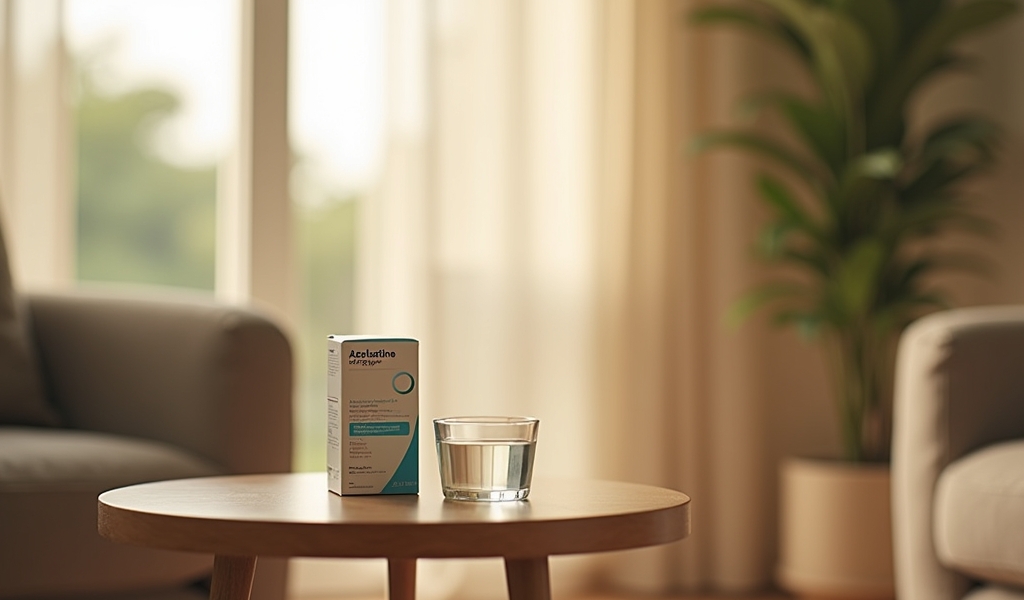Overview
Azelastine eye drops are a prescription antihistamine medication that provides fast, targeted relief for moderate to severe allergic conjunctivitis by blocking histamine receptors in the eyes, effectively reducing itching, redness, tearing, and swelling. Unlike over-the-counter alternatives, these prescription drops work within minutes, require just twice-daily dosing, and directly address the root cause of eye allergies with minimal systemic side effects, making them an excellent option for those whose symptoms significantly impact their quality of life according to Dr Telx.
Table of Contents
- Introduction
- What Are Azelastine Eye Drops?
- How Azelastine Works
- Medical Uses and Indications
- Benefits of Azelastine Eye Drops
- Prescription Requirements
- Proper Administration
- Potential Side Effects
- Drug Interactions
- Special Populations
- Comparing Azelastine to Alternatives
- When to Consider Azelastine Eye Drops
- Tips for Managing Eye Allergies
- Conclusion
- Frequently Asked Questions
Introduction
Dealing with itchy, watery eyes during allergy season can turn a beautiful spring day into a miserable experience. If you’re among the millions who battle eye allergies, you’ve probably tried countless over-the-counter remedies with limited success. Azelastine eye drops prescription medication might be the solution you’ve been searching for. This powerful antihistamine eye drop specifically targets allergy symptoms where they start, providing quick and effective relief.
Eye allergies (allergic conjunctivitis) affect an estimated 40% of Americans, with numbers steadily increasing due to climate change extending pollen seasons and environmental pollutants. The need for effective treatments has never been greater, especially for those whose symptoms significantly impact their quality of life.
In this comprehensive guide, we’ll explore everything you need to know about azelastine eye drops – from how they work to who can benefit most from this prescription treatment.
What Are Azelastine Eye Drops?
Azelastine hydrochloride ophthalmic solution is a prescription antihistamine medication that comes in eye drop form. Unlike many over-the-counter allergy eye drops that simply wash away allergens or temporarily constrict blood vessels, azelastine targets the underlying allergic response itself.
These eye drops belong to a class of medications called H1 receptor antagonists, which means they specifically block histamine – the chemical your body releases during an allergic reaction that causes those frustrating symptoms. What makes azelastine different from many other eye allergy treatments is its direct and potent action on the histamine receptors in your eyes.
While many people are familiar with oral antihistamines, azelastine eye drops deliver the medication exactly where it’s needed most. This targeted approach often results in faster relief with fewer systemic side effects than oral medications.

How Azelastine Works
To understand why azelastine eye drops work so effectively, it helps to know what happens during an eye allergy attack. When allergens like pollen, pet dander, or dust mites come into contact with your eyes, your immune system goes into defensive mode. It releases histamine, which binds to receptors on cells in your eye tissue.
This binding process triggers the classic symptoms of eye allergies: itching, redness, tearing, and swelling. It’s like your eyes are throwing a wild histamine party that you definitely didn’t want to host!
Azelastine works by acting as a bouncer at this unwanted party. The medication selectively blocks H1 histamine receptors, preventing histamine from binding to them. When histamine can’t connect with these receptors, it can’t trigger the allergic response, and your symptoms quickly begin to subside.
What’s particularly impressive about azelastine is how quickly it starts working – many patients report feeling relief within minutes of application. The American Academy of Ophthalmology notes that azelastine has a rapid onset of action compared to many other allergy treatments.
Medical Uses and Indications
Azelastine eye drops are primarily prescribed for allergic conjunctivitis – the medical term for eye allergies. However, not all eye allergies are created equal, and azelastine can address several different types:
Seasonal allergic conjunctivitis is the most common type, occurring during specific times of year when certain allergens like pollen are prevalent. If you find your eyes becoming itchy and watery every spring when the trees bloom, this might be your issue.
Perennial allergic conjunctivitis occurs year-round and is typically triggered by indoor allergens like dust mites, mold, or pet dander. These persistent allergies can be particularly frustrating as they offer no seasonal reprieve.
In some cases, azelastine may also be prescribed for vernal keratoconjunctivitis, a more severe form of eye allergy that typically affects children and young adults, particularly during warm weather.
While azelastine prescriptions are specifically approved for allergic conjunctivitis, some ophthalmologists may occasionally use them off-label for other inflammatory eye conditions when appropriate. Always follow your doctor’s guidance regarding the specific condition being treated.
Benefits of Azelastine Eye Drops
What makes azelastine eye drops worth considering? For many allergy sufferers, the benefits are compelling:
First, the speed of relief is remarkable. While oral antihistamines might take an hour or more to kick in, azelastine eye drops typically begin working within 3-15 minutes. When your eyes feel like they’re on fire with itching, that quick relief can be a game-changer.
Another major advantage is the comprehensive symptom relief. Azelastine tackles multiple symptoms simultaneously – reducing itching, redness, tearing, and swelling all at once. Rather than needing separate products for different symptoms, this one medication addresses the full spectrum of eye allergy manifestations.
Compared to over-the-counter options like artificial tears or redness relievers, azelastine offers more targeted relief by addressing the root cause of allergies rather than just temporarily masking symptoms. Over-the-counter decongestant eye drops (the ones that “get the red out”) can actually cause rebound redness if used too frequently, while azelastine doesn’t carry this risk.
Many patients also appreciate the twice-daily dosing schedule, which means you don’t need to carry eye drops with you everywhere and apply them multiple times throughout the day. Morning and evening applications are typically sufficient to maintain relief.

Prescription Requirements
Unlike some allergy treatments, azelastine eye drops aren’t available over the counter – they require a prescription from a healthcare provider. There are several good reasons for this requirement.
First, the potent antihistamine formulation requires proper medical supervision to ensure it’s appropriate for your specific condition. Not all red or irritated eyes are caused by allergies – similar symptoms could indicate infections, dry eye syndrome, or other conditions that need different treatments.
The typical prescription process is straightforward. You’ll need an appointment with an eye doctor (ophthalmologist or optometrist) or your primary care physician. During this visit, the doctor will examine your eyes, discuss your symptoms and medical history, and determine if azelastine is appropriate for you.
Insurance coverage for azelastine varies by plan. Many insurance providers cover it with a standard prescription copay, especially if you’ve already tried less expensive options. Without insurance, brand-name versions can be costly, but generic alternatives may be more affordable. Some manufacturers also offer patient assistance programs to help with costs.
If you’re looking for a convenient way to get evaluated, online prescription services now make it possible to consult with healthcare providers virtually and have your prescription sent directly to your local pharmacy.
Proper Administration
Using azelastine eye drops correctly ensures you get maximum benefit with minimal side effects. Here’s a step-by-step guide to proper application:
1. Wash your hands thoroughly with soap and water.
2. Gently shake the bottle if directed on the packaging.
3. Tilt your head back slightly and pull down your lower eyelid to create a small pocket.
4. Hold the dropper above your eye, being careful not to touch your eye, eyelashes, or any surface with the tip.
5. Look up and away from the dropper as you squeeze one drop into the pocket of your lower eyelid.
6. Close your eye gently for 1-2 minutes, avoiding blinking or squeezing your eyes shut.
7. Apply gentle pressure to the inner corner of your eye (where it meets your nose) for about a minute to prevent the medication from draining too quickly.
8. If you use multiple eye medications, wait at least 5-10 minutes between applications.
The typical dosage is one drop in each affected eye twice daily, though your doctor may adjust this based on your specific needs. Always follow your doctor’s instructions regarding frequency and duration of treatment.
For storage, keep azelastine eye drops at room temperature and away from direct sunlight. Most formulations should be used within 30 days after opening, so note the date when you first open the bottle and discard any remaining solution after that time frame.
Potential Side Effects
While azelastine eye drops are generally well-tolerated, being aware of possible side effects helps you know what’s normal and what might require medical attention.
Common side effects that typically don’t require medical attention include:
• Temporary burning or stinging upon application
• Mild eye irritation
• Bitter taste in the mouth (as the drops drain through your tear ducts)
• Mild headache
• Slightly blurred vision immediately after application
These effects usually subside quickly as your body adjusts to the medication. The bitter taste, which many patients report, happens when the medication drains through your tear ducts into the back of your throat – a normal occurrence with many eye drops.
Less common side effects that warrant contacting your doctor include:
• Severe or persistent eye irritation
• Significant changes in vision
• Eye pain
• Signs of eye infection (increased redness, discharge, or sensitivity to light)
• Allergic reaction to the medication itself (rare, but possible)
According to research from the National Library of Medicine, serious adverse reactions to azelastine eye drops are uncommon, which contributes to its favorable safety profile.
Drug Interactions
Azelastine eye drops rarely cause significant drug interactions because they primarily work locally in the eye with minimal systemic absorption. However, there are still some considerations to keep in mind.
If you’re taking other medications containing antihistamines (including oral allergy medications, some cold/flu products, and certain sleep aids), let your doctor know. While the risk of interaction is low, combining multiple antihistamines could potentially intensify side effects like drowsiness.
For contact lens wearers, you’ll need to remove your lenses before applying azelastine and wait at least 10-15 minutes before reinserting them. Some preservatives in the drops can be absorbed by soft contact lenses, causing irritation or discoloration.
Regarding alcohol, there’s no specific prohibition against moderate alcohol consumption while using azelastine eye drops. However, both alcohol and antihistamines can cause drowsiness, so be cautious about combining them, especially if you’re sensitive to either substance’s effects.
Always provide your doctor with a complete list of all medications, supplements, and herbal products you’re taking to ensure there are no potential concerns.
Special Populations
Azelastine eye drops may require special considerations for certain groups:
For children, azelastine is generally approved for those 3 years and older. The dosage is typically the same as for adults, but pediatric patients may need assistance with proper application. Children often respond well to azelastine, and its minimal systemic effects make it a good option for pediatric allergic conjunctivitis.
Regarding pregnancy, azelastine falls into FDA Pregnancy Category C, meaning animal studies have shown some adverse effects, but adequate human studies are lacking. The benefits may outweigh risks in some cases, but this requires careful individual assessment. Always discuss with your healthcare provider if you’re pregnant or planning to become pregnant.
For nursing mothers, it’s unknown if azelastine passes into breast milk in significant amounts when used as eye drops. Since systemic absorption is minimal, the risk to a nursing infant is likely low, but consultation with a healthcare provider is recommended.
Elderly patients generally tolerate azelastine eye drops well with no specific dose adjustments needed. However, older adults may be more sensitive to antihistamine effects and should report any unusual symptoms promptly.
Comparing Azelastine to Alternatives
How does azelastine stack up against other eye allergy treatments? Let’s compare:
Versus over-the-counter antihistamine eye drops (like ketotifen): Azelastine is generally more potent and may work better for moderate-to-severe symptoms. However, OTC options are more accessible and less expensive, making them reasonable first-line treatments for mild allergies.
Compared to mast cell stabilizers (like cromolyn sodium): Azelastine works faster but mast cell stabilizers may be better for long-term prevention when used consistently before exposure to allergens. Some newer formulations combine both approaches for comprehensive relief.
Versus steroid eye drops: Azelastine has fewer long-term safety concerns than steroid drops, which can increase eye pressure and potentially cause cataracts with prolonged use. Steroids are typically reserved for severe allergic reactions or when other treatments fail.
Oral antihistamines versus azelastine eye drops: Systemic oral medications affect your entire body and often cause drowsiness or dry mouth. In contrast, prescription eye drops deliver targeted relief directly where needed with minimal systemic effects.
From a cost perspective, generic azelastine can be reasonably priced with insurance coverage, but brand-name versions may be costly. Over-the-counter options are less expensive upfront but may not provide sufficient relief for moderate-to-severe symptoms, potentially costing more in the long run if you need to try multiple products.
When to Consider Azelastine Eye Drops
You might be a good candidate for azelastine eye drops if you experience any of these situations:
If your eye allergy symptoms include significant itching, redness, tearing, and swelling that interferes with daily activities or comfort, azelastine may provide the relief you need. These drops are particularly valuable when symptoms are moderate to severe.
Have you tried over-the-counter eye drops without satisfactory relief? This is a common reason people seek prescription alternatives. If you’re still suffering despite using OTC products as directed, it’s time to talk to your doctor about prescription options.
For seasonal allergy sufferers, timing matters. Consider discussing azelastine with your doctor about 1-2 weeks before your typical allergy season begins. Starting treatment before symptoms peak can provide better control throughout the season. Some doctors may even recommend preventive use during your known allergy seasons.
If your allergies are significantly impacting your quality of life – interfering with work, school, driving, or other important activities – the stronger relief provided by prescription treatment may be warranted.
Tips for Managing Eye Allergies
While azelastine eye drops can provide excellent symptom relief, combining them with these strategies can maximize your comfort:
Minimize exposure to allergens whenever possible. Keep windows closed during high pollen seasons, use air purifiers with HEPA filters, and consider wearing wraparound sunglasses outdoors to reduce allergen contact with your eyes.
Apply cold compresses to your closed eyes for 5-10 minutes several times daily to reduce swelling and soothe irritation. Store a clean washcloth in the refrigerator for quick, cooling relief.
Practice good eyelid hygiene by gently washing your eyelids daily with baby shampoo or specialized eyelid cleansers to remove allergens that may have accumulated on your lashes and lid margins.
Consider using preservative-free artificial tears frequently throughout the day to flush allergens from the eye surface. These can be used alongside azelastine eye drops (just wait 5-10 minutes between applications).
Avoid rubbing your eyes, no matter how tempting! Rubbing not only irritates already sensitive tissues but can also transfer more allergens from your hands to your eyes, worsening symptoms.
Conclusion
Azelastine eye drops offer powerful, targeted relief for those suffering from eye allergies that don’t respond adequately to over-the-counter treatments. With their fast-acting formula, comprehensive symptom relief, and twice-daily dosing convenience, they represent an excellent prescription option for moderate to severe allergic conjunctivitis.
While they do require a doctor’s prescription and may have some mild side effects, most patients find the benefits far outweigh these minor considerations. The ability to enjoy clear, comfortable vision during allergy season can dramatically improve quality of life for chronic allergy sufferers.
Remember that azelastine works best as part of a comprehensive allergy management plan that includes minimizing allergen exposure and potentially using complementary treatments. By working closely with your healthcare provider, you can develop a personalized approach to keeping your eyes comfortable year-round.
If you’re tired of battling itchy, watery eyes every allergy season, it might be time to ask your doctor if azelastine eye drops could be the solution you’ve been searching for. Clear vision and comfortable eyes are possible, even for those with persistent allergies!
Frequently Asked Questions
How quickly do azelastine eye drops start working?
Most patients experience relief within 3-15 minutes after application, with maximum effect typically occurring within 3 hours.
Can I wear contact lenses while using azelastine eye drops?
Remove contacts before applying drops and wait 10-15 minutes before reinserting them to prevent absorption of the medication by the lens material.
How long can I safely use azelastine eye drops?
Most doctors recommend using them only during symptomatic periods or allergy seasons, typically for a few weeks to months at a time.
Will azelastine eye drops make me drowsy like oral antihistamines?
Drowsiness is uncommon with azelastine eye drops because very little medication is absorbed into the bloodstream when properly applied.
Can children use azelastine eye drops?
Yes, azelastine is generally approved for children 3 years and older, using the same dosage as adults but with assistance for proper application.

